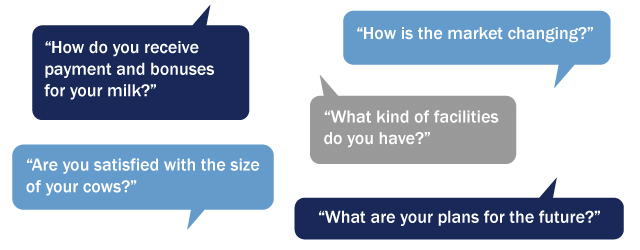Genetics keep improving. So should your mating program.
Meet Genetic Management System® (GMS®) 2.0 – an innovative, completely redesigned mating program built with your unique goals in mind.
Introduced in 2016, GMS 2.0 continues to offer sound, unbiased mating selections based on economically important production, health, and type traits. The result: longer-lasting, profitable cows.
Its predecessor, the comprehensive GMS, has been simplifying the breeding process and optimizing genetic progress for nearly half a century.
“Through GMS 2.0, we are showing you that your ideas and input are important to designing a genetic plan for your herd.”
Alireza Mohammadi, Key Account Manager, Iran
Customisation
One size may not fit all, but we’re definitely able to tailor our program to fit you. GMS 2.0 can be customised more than 150 different ways – even before we choose sires. Each of these Customer Controlled Breeding Options is tailored to your operation’s specific objectives.
After working with a Genus ABS representative to answer all the right questions, you can choose from five production and five conformation options – including ROBOT-specific – to figure out which ones fit best at your operation.

You’ll also get to rank three different objectives: increased production, gaining efficiencies through improved herd health, and improved cow conformation. Are some of these less important than others? Is one more important than all else? You get to decide.
No matter which of the above directions you take, some features always come standard. For example, GMS 2.0 continues to help manage inbreeding levels, offering the most complete protection against detrimental recessives, haplotypes, and genetic saturation.

Utilising Genomics
Looking to gain more value from your genomic results? Using them in GMS 2.0 helps deliver more accurate mating recommendations.
Why use genomics with GMS 2.0?
Manage genomic inbreeding
- Every artificial insemination (AI) company calculates inbreeding differently, making it impossible to compare percentages calculated by different companies. With genomic inbreeding, the percentage of common genes found on an animal’s genome is reported. GMS 2.0 uses these genomic inbreeding percentages to help manage herd inbreeding with more precision than ever before.
Remove phenotypic bias
- The phenotype of an animal is a combination of her genetics with her environment. This combination determines how healthy she is, how big she grows, and how much milk she produces. However, only her genetics will be passed onto her offspring – she cannot pass along all the environmental factors that have impacted her throughout her life. Utilising an animal’s genomic information provides more accuracy and precision, and removes any possibility of phenotypic bias from affecting the mating recommendation.
What benefits will you enjoy?
Your animals’ genomic values never become outdated.
- On average, genomic values change every four months as the genomic database gets updated with new information. With GMS 2.0, we always use the most recent and accurate genomic values available. Count on it.
The process is much simpler than you might think.
- No need to shuffle through stacks of paper to find genomic results. The only number we need is the permanent ID that was used to genomic-test your animals – often a registration, RFID, or other common permanent ID number. It’s that simple.
Measuring Progress
With more than 14 different customisable reports, GMS 2.0 lets you keep close track of your herd’s genetic progress. You can even get reports that help you manage your semen inventory, monitor inbreeding, and visualise herd progress for production, health and type traits.
Customers Using GMS

Tim Sinnott milks 225 cows on an autumn block calving system in Warwickshire. Calving from July through to November with all fertility work done by the Genus Reproductive Management System (RMS) team. The cows are milked three times daily with yields at 12,700lts/cow milk sold which equates to 890kg milk solids sold per cow. “In […]
Tim Sinnott, Warwickshire

Johnson Rolling Acres is a family farm that has been in business since 1979. After starting out milking 36 cows, the farm has steadily milked more cows to support a growing family. The most recent expansion was in 2012 when the Johnson’s built a cross-ventilated freestall barn and expanded to 1,200 milking cows. As a […]


